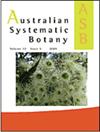走向世界陆地生物地理区域化:历史笔记、特征描述和区域命名
IF 1.6
3区 生物学
Q4 EVOLUTIONARY BIOLOGY
引用次数: 9
摘要
摘要根据Morrone于2015年发表在《澳大利亚系统植物学》上的工作,提供了世界陆地区域的临时分级分类(即生物地理区域化或区域分类学)。地区名称是根据《国际地区命名法》列出的,以同义多余的名称。分区域级的临时全球陆地区域化包括3个王国、2个子王国、8个区域、21个子区域和5个过渡带。没有为这些区域提出新名称;然而,Lydekker的线路更名为Illiger的线路。我们注意到,一些区域仍然需要在次区域一级进行区域分类,特别是北极地区、埃塞俄比亚和东方地区。今后,以下临时全球区域化可作为未来进一步修订和增加新领域的模板。本文章由计算机程序翻译,如有差异,请以英文原文为准。
Toward a terrestrial biogeographical regionalisation of the world: historical notes, characterisation and area nomenclature
ABSTRACT An interim hierarchical classification (i.e. biogeographical regionalisation or area taxonomy) of the world’s terrestrial regions is provided, following the work of Morrone published in Australian Systematic Botany in 2015. Area names are listed according to the International Code of Area Nomenclature so as to synonymise redundant names. The interim global terrestrial regionalisation to the subregion level recognises 3 kingdoms, 2 subkingdoms, 8 regions, 21 subregions and 5 transition zones. No new names are proposed for the regions; however, Lydekker’s Line is renamed Illiger’s Line. We note that some regions still require area classification at the subregion level, particularly the Palearctic, Ethiopian and Oriental regions. Henceforth, the following interim global regionalisation may be used as a template for further revisions and additions of new areas in the future.
求助全文
通过发布文献求助,成功后即可免费获取论文全文。
去求助
来源期刊

Australian Systematic Botany
生物-进化生物学
CiteScore
3.10
自引率
12.50%
发文量
12
审稿时长
>12 weeks
期刊介绍:
Australian Systematic Botany is an international journal devoted to the systematics, taxonomy, and related aspects of biogeography and evolution of all algae, fungi and plants, including fossils. Descriptive taxonomic papers should normally constitute a comprehensive treatment of a group. Short papers on individual species and nomenclatural papers must contain significant new information of broader interest to be considered. The prestigious L.A.S. Johnson Review Series is published. Other review articles will also be considered. All papers are peer reviewed.
Australian Systematic Botany is published with the endorsement of the Commonwealth Scientific and Industrial Research Organisation (CSIRO) and the Australian Academy of Science.
 求助内容:
求助内容: 应助结果提醒方式:
应助结果提醒方式:


